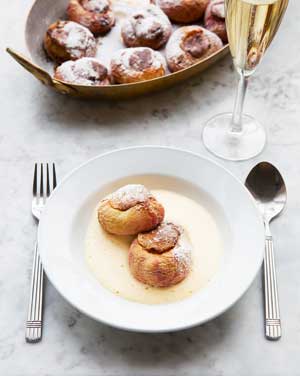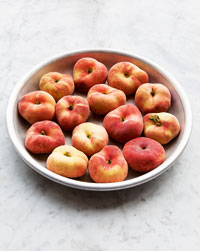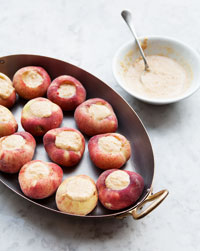Rowley Leigh’s recipe for stuffed peaches

Simply sign up to the Life & Arts myFT Digest -- delivered directly to your inbox.
There is a possibility that much of this year’s soft fruit will not be of the highest standard. The late spring will mean that the fruit will have had a shorter growing season and will probably all arrive at the same time, as the growing cycle desperately tries to catch up with its normal timetable. There is always the danger that the fruit will ripen without achieving any great depth of flavour.
Let us hope that grumpy old me has got it wrong and there is suddenly a load of superb berries and stone fruit alongside a sudden brilliant bright summer. Even if that is the case and we enjoy the most luscious apricots and nectarines for our breakfasts, gorge ourselves on the ripest blackcurrants with nothing but a blob of the finest clotted cream with our lunch and finish our dinners with bowlfuls of wild strawberries and the most exquisite lemon sorbet, there will still be the time to stuff a peach. If, however, I am correct in my pessimistic prognostications, stuffing and baking the peaches will be much the best thing to do with them.
There is a prejudice, first voiced by Shirley Conran, against too much stuffing of fruit and vegetables. The comment has always upset me but has not deterred me from stuffing tomatoes, courgettes and even mushrooms with some abandon. Part of the point is to replace a seedy core with something more substantial, the other is to add an extra dimension of flavour. Stuffing a tomato with soft breadcrumbs, parsley and garlic does just that. Stuffing a peach with almonds does something similar but also explores the genetic affinity between the fruit and the nut.
Many years ago I bought a handsome little peach tree from a respectable nursery only to discover, a couple of years later, that the only fruit it would ever bear was a very limited quantity of almonds. Crack open a peach stone and you get a kernel the shape and taste of an almond. I used to incorporate these nuts into my stuffing mixture but having learnt that the kernels contain a very small percentage of cyanide, I no longer do so.
As though to confirm my suspicions about this year’s production, I could only find flat peaches on the day of the shoot. Time was that these, like the deep red pêches de vigne, were great rarities but both have become increasingly common. They have an excellent flavour but removing the stone involved a bit of digging about with a scoop; slightly more problematic than simply splitting a large peach in half – and pulling out and throwing away the stone.
Rowley Leigh is the chef at Le Café Anglais
Twitter @lecafeanglais
——————————————-

Stuffed peaches
Ingredients
Best when cooled a little from the oven but still warm. Serves six.
7 large or 14 small peaches
1 lemon
2 egg yolks
30g sugar
6 amaretti biscuits or macaroons
Icing sugar
Split the peaches in half and remove the stones. Scoop out a little of the flesh with a spoon to enlarge the cavities left by the stones. Spoon a little lemon juice into the cavities. Peel the last peach and mash its pulp with that of the others in a mortar to make a paste, then add the egg yolks and sugar and finally the macaroons. Continue to mash together but keep a loose and granular texture. Add a squeeze of lemon juice and a teaspoon or two of rum if you have it to hand.
Spoon this mixture into the peach cavities before putting the peaches skin-side down in an ovenproof dish. Sprinkle with icing sugar and bake in a 180C oven for about 20 minutes. Serve immediately, or at room temperature an hour or two later.
——————————————-

Moscato zabaglione
Ingredients
Normally made with marsala, this zabaglione is much lighter but the insistent Muscat flavour of the Moscato is never far away. It is a lovely – if indulgent – dessert in its own right, especially when served with freshly baked sponge fingers.
4 egg yolks
65g caster sugar
125ml Moscato d’Asti
Whisk together the ingredients in a large bowl. Set the bowl over a pan of simmering water and proceed to whisk steadily until the mixture slowly starts to thicken and increase in volume. Keep going until the mixture holds its shape and there is no liquid at the bottom of the bowl. Serve the zabaglione in a jug alongside the peaches, or with them in a bowl.
——————————————-
Rowley’s drinking choice
Very simple: at about 5.5 per cent alcohol, Moscato is a refreshing way to finish a meal and, with a tiny hint of acidity, a perfect foil for the baked peaches. Serve pretty cold.
Comments